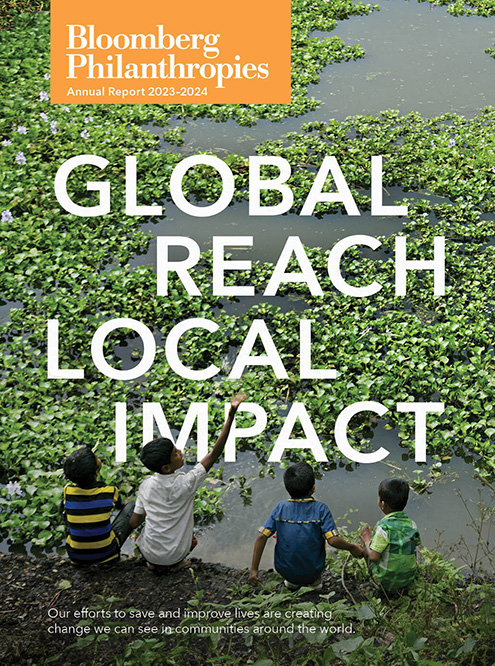
CEO Letter
Patricia E. Harris
The progress we’ve made with our partners shows that no dream is too big when we tap into the power of collaboration.
Collaboration is at the heart of everything we do at Bloomberg Philanthropies.
Whether it’s our open floor plan (no private offices and no walls separating teams), or the way we get involved in major challenges (enlisting expert partners to help shape our strategy), or how we spread the best ideas (convening leaders from diverse backgrounds and organizations), our deep belief in the value of collaboration comes from years of experience, often outside of philanthropy.
As an entrepreneur and business leader, Mike has always focused on ensuring we have a nimble and efficient team that can move quickly to address pressing global issues — and direct as much of our giving as possible to organizations on the ground that are making a difference. Rather than creating Bloomberg Philanthropies offices in other cities and countries, we invest in partners, from cities and their leaders to nonprofits and advocates, who have years of experience and credibility in the places and issues where we want to be working. As an organization with a global reach, we can play a unique role not just in supporting these partners but in bringing them together, often for the first time, to spark new insights and share strategies.
Global Reach
Bloomberg Philanthropies works to improve the lives of millions of people in more than 700 cities and 150 countries.

Our work is also informed by our team’s background in local government, led by Mike as mayor of New York City for 12 years. That experience gave us enormous appreciation for how powerful local leadership can be, and where philanthropy can play a role in strengthening it. It also showed us that collaboration between the public and private sectors can create better and more lasting progress, thanks to the different strengths, resources, and expertise each offers. While philanthropy can gather data, test ideas, and take risks to figure out what works, government has the ability to sustain and scale the work, helping to save and improve millions more lives. Transformative change often requires government policy and partnership, an idea that drives many of our initiatives.
In the Bloomberg Philanthropies 2023/2024 Annual Report, you’ll read more about the results we’ve achieved, thanks to an incredible group of partners. All of that progress is deeply rooted in collaboration, which we’ve always seen as a critical element of our approach. Here are just a few examples:
PROTECTING PUBLIC HEALTH.
Our global program to reduce the toll of tobacco use is one of our biggest and longest-running partnerships. It brings together nonprofits like the Campaign for Tobacco-Free Kids, international authorities like the World Health Organization, government officials including ministers of finance in charge of national tax policies, and community leaders who are working to reduce the death toll from smoking. Since we launched the initiative in 2007, we’ve helped protect nearly four billion people in 85 countries with strong tobacco control laws — helping cut global smoking rates by nearly a quarter. In 2023, that progress drove us to reinvest in our initiative with a new $420 million commitment.
SUPPORTING PUBLIC ART.
The arts are a driver of economic growth, attracting visitors that generate revenue. They bring life and vitality to communities, and they bring people together and allow us to see the world through the eyes of others. Last year, we announced eight winning cities in the third edition of our Public Art Challenge, which brings together mayors, artists, and community members to work on public art projects that tackle important issues — from hunger to climate change to gun violence. Each of the winning cities receives up to $1 million to create stunning, collaborative art installations that address their chosen challenge.
ENDING COAL USE.
In 2011, we teamed up with the Sierra Club to launch a U.S. campaign called Beyond Coal, focused on the single biggest driver of climate change and a huge source of deadly pollution. Our goal: to replace coal-burning plants with clean energy. The campaign, which we’ve since expanded to tackle other fossil fuels like methane gas, is a true bottom-up collaborative effort, joining forces with local communities that are fighting for clean air and water. Our partners at the Sierra Club and dozens of other organizations have helped lead the way forward, working with experts and lawyers to ensure that power plant operators are following laws that protect people from pollution, and providing state utilities with data that makes the economic case to switch to clean energy.
Since we began, more than 72 percent of U.S. coal plants have been retired. In 2023, we reached important new milestones: U.S. emissions from coal power hit a record low, as coal-powered electricity generation fell to the lowest level in a half century. And in March 2024, two more coal plant retirements put the New England region on track to soon be entirely coal-free. Based on this success, we’ve continued to expand our collaboration on coal and clean energy to more countries around the world.
We’ve also worked to accelerate the global energy transition through major collaborations focused on climate finance — bringing together philanthropy, government, multilateral development banks, and the private sector to mobilize financing for clean energy and other climate solutions. No single sector can solve the challenge alone, and our efforts are bringing together global partners who can make progress, faster.
PREPARING STUDENTS TO SUCCEED.
On another major priority, our Education team is helping to prepare U.S. students for successful careers in a changing economy. That work brings together educators, business leaders, and nonprofits to help more students acquire the skills and training experience that employers are seeking. Earlier this year, as Mike mentioned in his letter, we expanded our efforts with a $250 million investment to create healthcare-focused high schools. Our goal is to open 10 new schools in 10 urban and rural areas, each a collaboration with local partners in healthcare and education. For instance, the school we are helping to create in New York City brings together Northwell Health and the city’s public school system, while in Boston, we’re working with Mass General Brigham and the Edward M. Kennedy Academy for Health Careers.
SUPPORTING WOMEN.
Since 2007, we have collaborated with nonprofits including Women for Women International and Sustainable Growers, as well as government partners, to provide training and education programs that lead to economic independence for women in Rwanda and the Democratic Republic of Congo. Last year, a long-term evaluation of our program showed significant, sustained gains in participants’ income and savings, providing data other countries can use to replicate the program across borders. More than 743,000 women have now been enrolled in our program, benefiting over 2.9 million of their children and family members.
STRENGTHENING CITY LEADERSHIP.
Beginning in 2017, through our Government Innovation work, we’ve brought together Harvard’s Business and Kennedy Schools to lead intensive management and leadership training sessions for mayors and their senior staff. In addition to reaching 275 mayors and nearly 470 staff from 35 countries, the Bloomberg Harvard City Leadership Initiative has also sparked new collaborations. In Israel, we’ve worked with Tel Aviv University to create the Bloomberg Sagol Center for City Leadership, and in Africa we’ve partnered with the University of Cape Town to support the African Mayoral Leadership Initiative for local leaders across the continent. These partnerships are bringing world-class expertise to strengthen the work of city leaders — and millions of residents are benefiting.
Our focus on cities also extends to the work that Bloomberg Associates leads. The team is providing client cities with pro bono guidance to address important priorities, from tackling climate change to addressing homelessness and affordable housing.
BUILDING SUSTAINABLE CITIES.
Another example from our work with cities is the Bloomberg American Sustainable Cities initiative, launched in 2024 to help 25 major U.S. cities tackle the biggest sources of greenhouse gas emissions, which also produce deadly air pollution whose burden often falls heaviest on low-income communities. The effort is a collaboration between our Environment and Government Innovation teams along with the team leading our Greenwood Initiative, which focuses on reducing racial wealth disparities in the United States. Fighting climate change, improving public health, and building more equitable cities go hand-in-hand — so it’s only natural that our program areas would work hand-in-hand with one another, and with mayors nationwide, to make the initiative as effective as it can be.
The progress we’ve made with our partners in these and other areas shows that no dream is too big when we tap into the power of collaboration. Of course, this work is all made possible by our greatest partnership of all — with Bloomberg L.P. — which gives the vast majority of its profits to support our efforts. And in the year ahead, we’ll continue drawing on the power of collaboration to tackle the world’s toughest challenges.

Patricia E. Harris
CEO, Bloomberg Philanthropies
